Effect of Process Parameters on Deposition Properties of Functionally Graded STS 316/Fe Manufactured by Laser Direct Metal Deposition
Abstract
:1. Introduction
2. Experimental Procedures
3. Results and Discussion
3.1. Effect of Process Parameters on the Bead Geometry
3.1.1. Contact Tip to Work-Piece Distance
3.1.2. Beam Shift
3.1.3. Laser Power
3.1.4. Flow Rate
3.1.5. Travel Speed
3.2. Additive Manufacturing
4. Conclusions
- The process conditions for producing sound beads without humping beads, pores, and lack of fusion were derived using Fe powder with uneven size and shape.
- The shape of the bead and the size of the pore were affected by the change of CTWD. The beam shift parameter had the effect of changing the angle of the bead, and the laser power was effective in changing the aspect ratio of the bead.
- Low flow rates caused puckering, while excessive flow rates reduced material efficiency. In addition, humping beads were observed at slow travel speed and many pores due to rapid solidification at high travel speed.
- The FGM samples showed gradual changes in composition and phase along the layers. In XRD analysis, any intermetallic compounds such as sigma phase was not detected.
- When the STS316 was directly deposited on the mild steel, there were many pores and cracks at the interface. However, when the FGM was produced by using Fe and STS316 powder, defects occurring at the interface of the first layer could be removed.
- However, as the Fe powder was mixed with STS316 powder, pores were observed between the interfaces, which resulted in the presence of chrome oxide at the interface.
Author Contributions
Funding
Acknowledgments
Conflicts of Interest
References
- Hwang, M.J.; Cho, J. Laser additive manufacturing technology review. J. Weld. Joining 2014, 32, 15–19. [Google Scholar] [CrossRef]
- Sun, Z.; Ion, J. Laser welding of dissimilar metal combinations. J. Mater. Sci. 1995, 30, 4205–4214. [Google Scholar] [CrossRef]
- Urbikain, G.; Perez, J.M.; López de Lacalle, L.N.; Andueza, A. Combination of friction drilling and form tapping processes on dissimilar materials for making nutless joints. Proc. Inst. Mech. Eng. Part B 2016, 232, 1007–1020. [Google Scholar] [CrossRef]
- Goodarzi, D.M.; Pekkarinen, J.; Salminen, A. Analysis of laser cladding process parameter influence on the clad bead geometry. Weld. World 2017, 61, 883–891. [Google Scholar] [CrossRef]
- Saqib, S.; Urbanic, R.J.; Aggarwal, K. Analysis of laser cladding bead morphology for developing additive manufacturing travel paths. Procedia CIRP 2014, 17, 824–829. [Google Scholar] [CrossRef]
- Oliveira, U.D.; Ocelik, V.; Hosson, J.T.M.D. Analysis of coaxial laser cladding processing conditions. Surf. Coat. Technol. 2005, 197, 127–136. [Google Scholar] [CrossRef]
- Calleja, A.; Tabernero, I.; Fernández, A.; Celaya, A.; Lamikiz, A.; López de Lacalle, L.N. Improvement of strategies and parameters for multi-axis laser cladding operations. Opt. Lasers Eng. 2014, 56, 113–120. [Google Scholar] [CrossRef]
- Calleja, A.; Tabernero, I.; Ealo, J.A.; Campa, F.J.; Lamikiz, A.; de Lacalle, L.N.L. Feed rate calculation algorithm for the homogeneous material deposition of blisk blades by 5-axis laser cladding. Int. J. Adv. Manuf. Technol. 2014, 74, 1219–1228. [Google Scholar] [CrossRef]
- Brentrup, G.; Dupont, J. Fabrication and characterization of graded transition joints for welding dissimilar alloys. Weld. J. 2013, 92, 72–79. [Google Scholar]
- Shah, K.; Haq, I.U.; Khan, A.; Shah, S.A.; Khan, M.; Pinkerton, A.J. Parametric study of development of Inconel-steel functionally graded materials by laser direct metal deposition. Mater. Des. 2014, 54, 531–538. [Google Scholar] [CrossRef]
- Wu, D.; Liang, X.; Li, Q.; Jiang, L. Laser rapid manufacturing of stainless steel 316L/Inconel718 functionally graded materials: Microstructure evolution and mechanical properties. Int. J. Opt. 2010, 2010, 1–5. [Google Scholar] [CrossRef]
- Reichardt, A.; Dillon, R.P.; Borgonia, J.P.; Shapiro, A.A.; Mcenerney, B.W.; Momose, T.; Hosemann, P. Development and characterization of Ti-6Al-4V to 304L stainless steel gradient components fabricated with laser deposition additive manufacturing. Mater. Des. 2016, 104, 404–413. [Google Scholar] [CrossRef]
- Li, W.; Karnati, S.; Kriewall, C.; Liou, F.; Newkirk, J.; Brown Taminger, K.M.; Seufzer, W.J. Fabrication and characterization of a functionally graded material from Ti-6Al-4V to SS316 by laser metal deposition. Addit. Manuf. 2017, 14, 95–104. [Google Scholar] [CrossRef]
- Li, W.; Liou, F.; Newkirk, J.; Brown Taminger, K.M.; Seufzer, W.J. Ti6Al4V/SS316 multi-metallic structure fabricated by laser 3d printing and thermodynamic modeling prediction. Int. J. Adv. Manuf. Technol. 2017, 92, 4511–4523. [Google Scholar] [CrossRef]
- Li, W.; Liou, F.; Newkirk, J.; Taminger, K.M.B.; Seufzer, W.J. Investigation on Ti6Al4V-V-Cr-Fe-SS316 multi-layers metallic structure fabricated by laser 3D printing. Sci Rep. 2017, 7, 7977. [Google Scholar] [CrossRef] [PubMed]
- Hofmann, D.C.; Roberts, S.; Otis, R.; Kolodziejska, J.; Dillon, R.P.; Suh, J.O.; Shapiro, A.A.; Liu, Z.K.; Borgonia, J.P. Developing gradient metal alloys through radial deposition additive manufacturing. Sci. Rep. 2014, 4, 5357. [Google Scholar] [CrossRef] [PubMed]
- Zhang, C.; Zhang, H.; Wu, C.; Zhang, S.; Sun, Z.; Dong, S. Multi-layer functional graded stainless steel fabricated by laser melting deposition. Vacuum 2017, 141, 181–187. [Google Scholar] [CrossRef]
- Li, W.; Yan, L.; Chen, X.; Zhang, J.; Zhang, X.; Liou, F. Directed energy depositing a new Fe-Cr-Ni alloy with gradually changing composition with elemental powder mixes and particle size’ effect in fabrication process. J. Mater. Process. Technol. 2018, 255, 96–104. [Google Scholar] [CrossRef]
- Fatima, S.; Khan, M.; Jaffery, S.H.I.; Ali, L.; Mujahid, M.; Butt, S.I. Optimization of process parameters for plasma arc welding of austenitic stainless steel (304 L) with low carbon steel (A.-36). Proc. Inst. Mech. Eng. Part L 2015, 230, 640–653. [Google Scholar] [CrossRef]
- Klueh, R.; King, J. Austenitic stainless steel-ferritic steel weld joint failures. Weld. J. 1982, 61, 302–311. [Google Scholar]
- Dupont, J.N. Microstructural evolution and high temperature failure of ferritic to austenitic dissimilar welds. Int. Mater. Rev. 2013, 57, 208–234. [Google Scholar] [CrossRef]
- Chuaiphan, W.; Chandra-Ambhorn, S.; Sornil, B.; Bleck, W. Microstructure, mechanical and corrosion behaviour of dissimilar weldments between AISI 304 stainless steels and AISI 1020 carbon steels produced by gas tungsten arc welding using different consumables. Key Eng. Mater. 2009, 410–411, 533–541. [Google Scholar] [CrossRef]
- Li, W.; Zhang, J.; Zhang, X.; Liou, F. Effect of optimizing particle size on directed energy deposition of functionally graded material with blown pre-mixed multi-powder. Manuf. Lett. 2017, 13, 39–43. [Google Scholar] [CrossRef]
- Hwang, J.H.; Shin, S.S.; Jung, G.I.; Kim, S.W.; Kim, H.D. A study on the characteristics of laser deposition surface and cross-section for metal powder. J. Weld. Joining 2016, 34, 17–22. [Google Scholar] [CrossRef]
- Qi, H.; Mazumder, J.; Ki, H. Numerical simulation of heat transfer and fluid flow in coaxial laser cladding process for direct metal deposition. J. Appl. Phys. 2006, 100. [Google Scholar] [CrossRef] [Green Version]
- Kam, D.H.; Kim, Y.M.; Kim, C. Recent studies of laser metal 3D deposition with wire feeding. J. Weld. Joining 2016, 34, 35–40. [Google Scholar] [CrossRef]
- Noda, N. Thermal stresses in functionally graded materials. J. Therm. Stress. 1999, 22, 477–512. [Google Scholar] [CrossRef]
- Charde, N.; Yusof, F.; Rajkumar, R. Material characterizations of mild steels, stainless steels, and both steel mixed joints under resistance spot welding (2-mm sheets). Int. J. Adv. Manuf. Tech. 2014, 75, 373–384. [Google Scholar] [CrossRef]
- Song, Y.A.; Park, S. Experimental investigations into rapid prototyping of composites by novel hybrid deposition process. J. Mater. Process. Technol. 2006, 171, 35–40. [Google Scholar] [CrossRef]
- Cleaves, H.E.; Hiegel, J.M. Properties of high-purity iron. J. Res. Natl. Bur. Stand. 1942, 28, 643–667. [Google Scholar] [CrossRef]

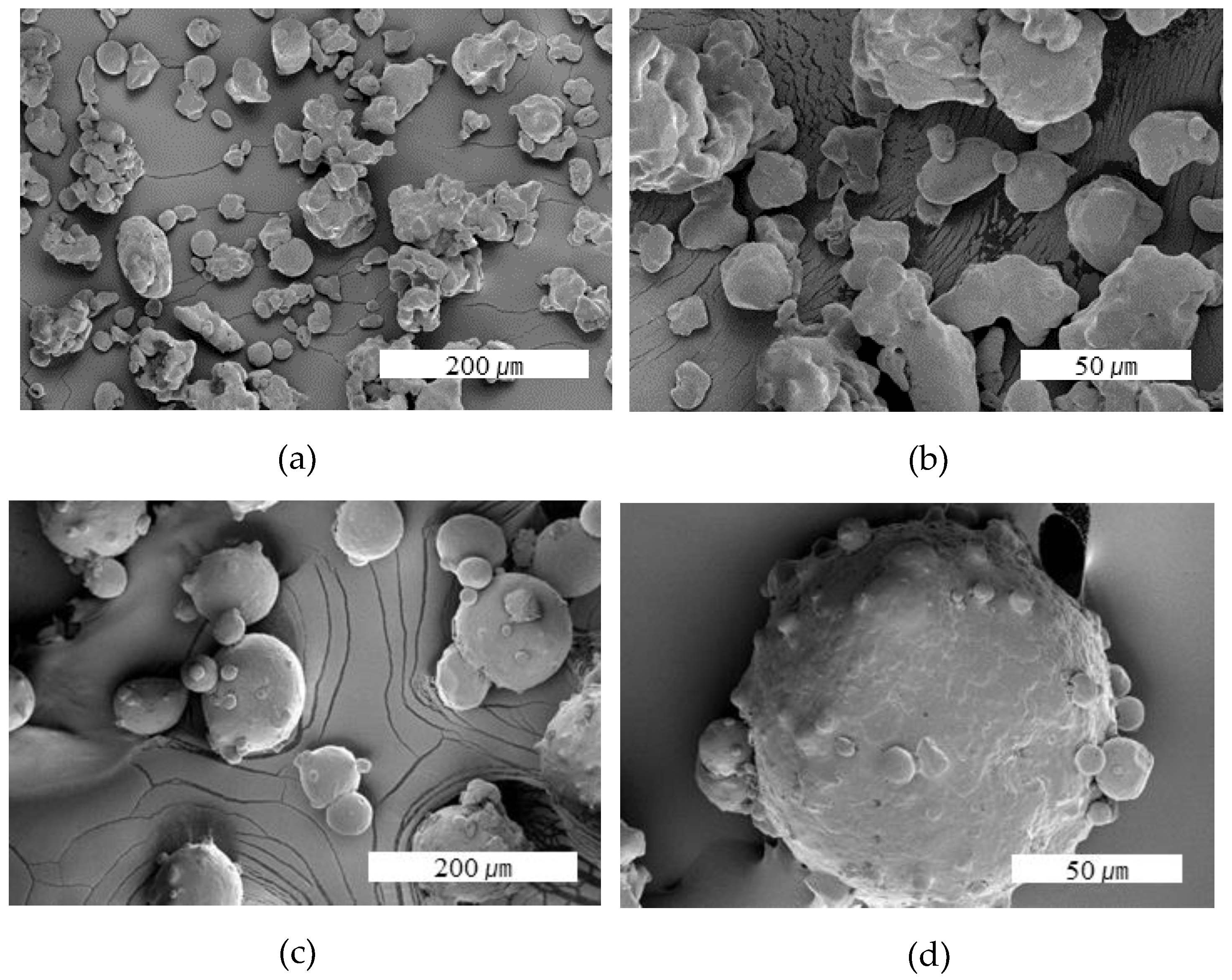
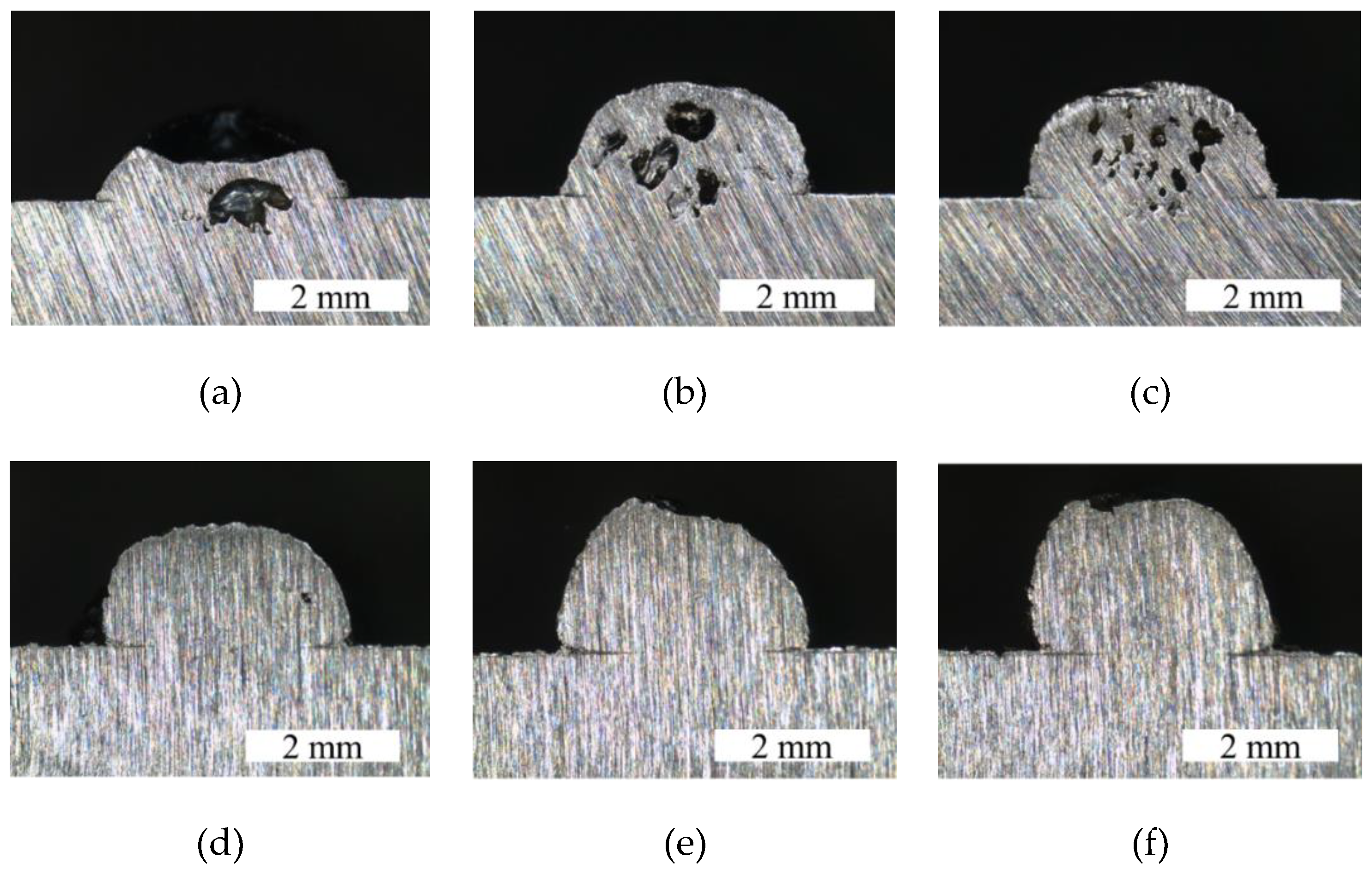


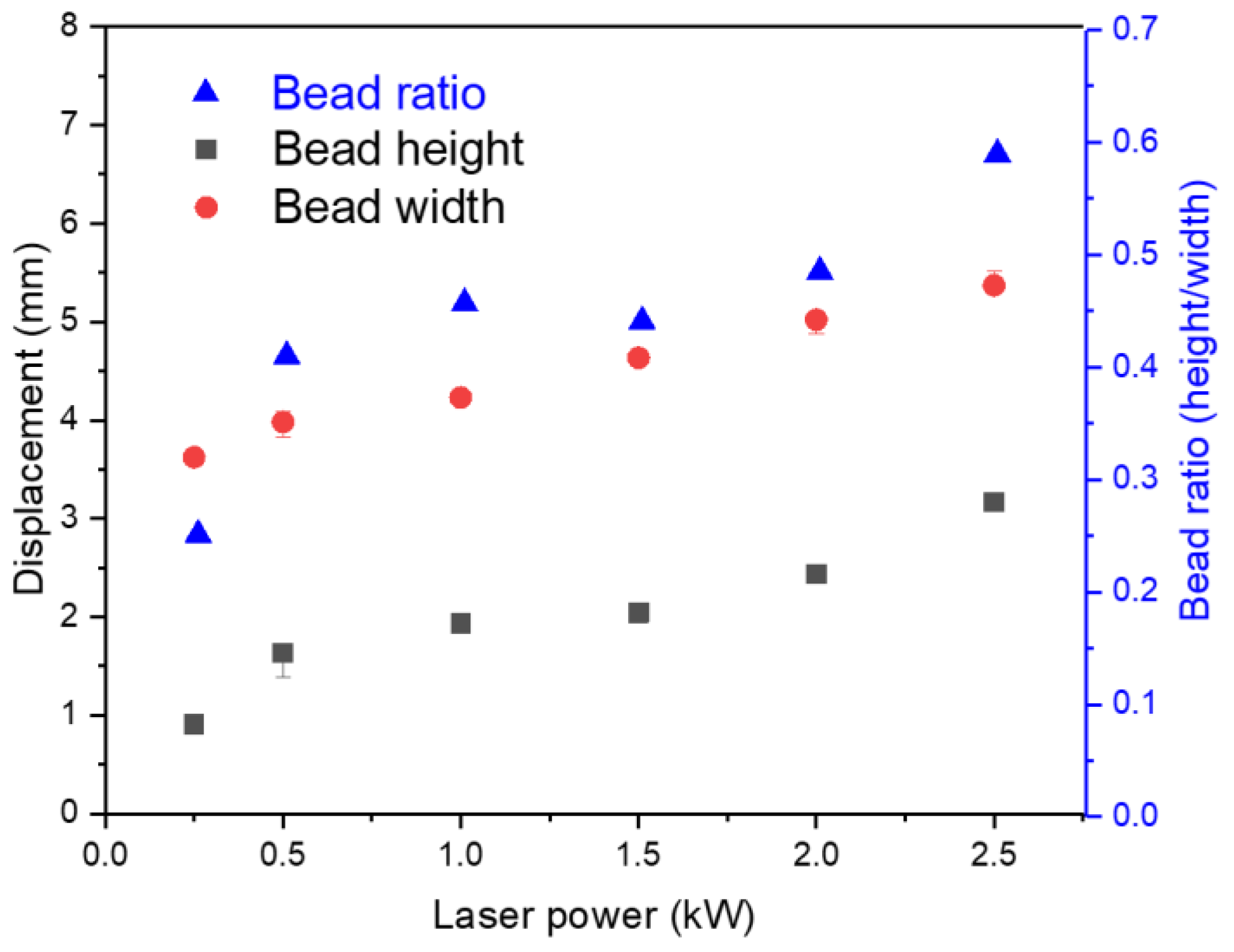
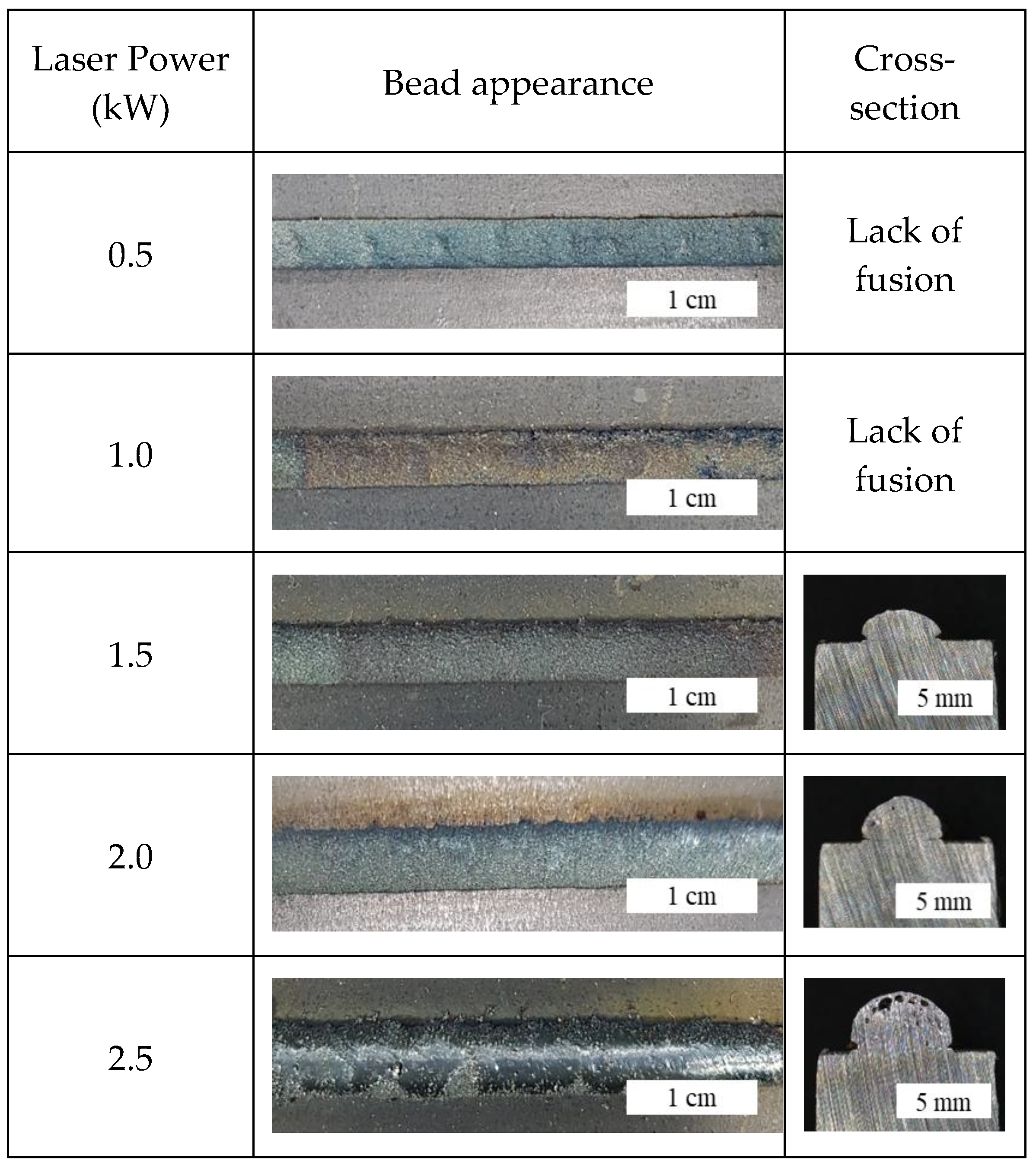
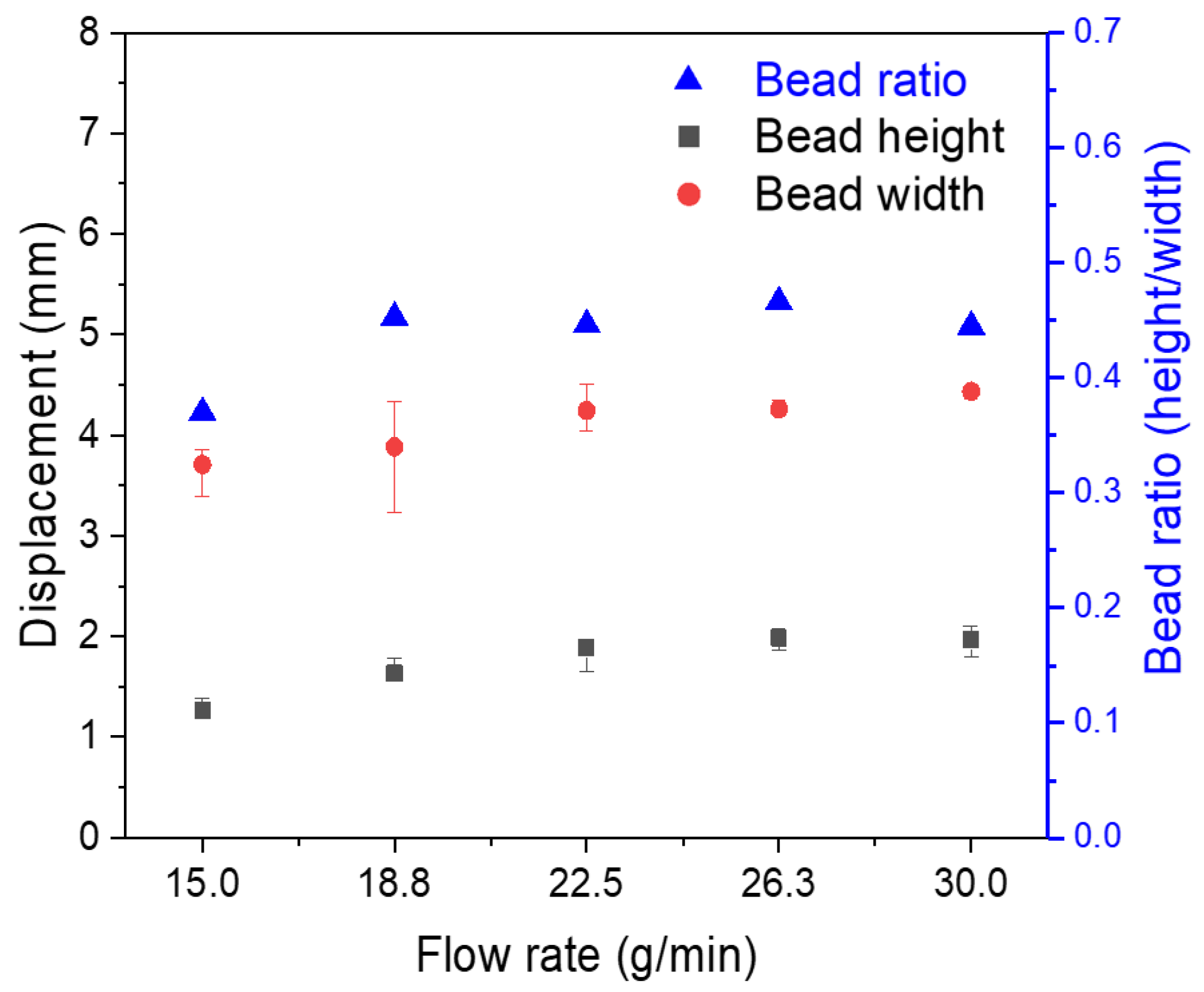
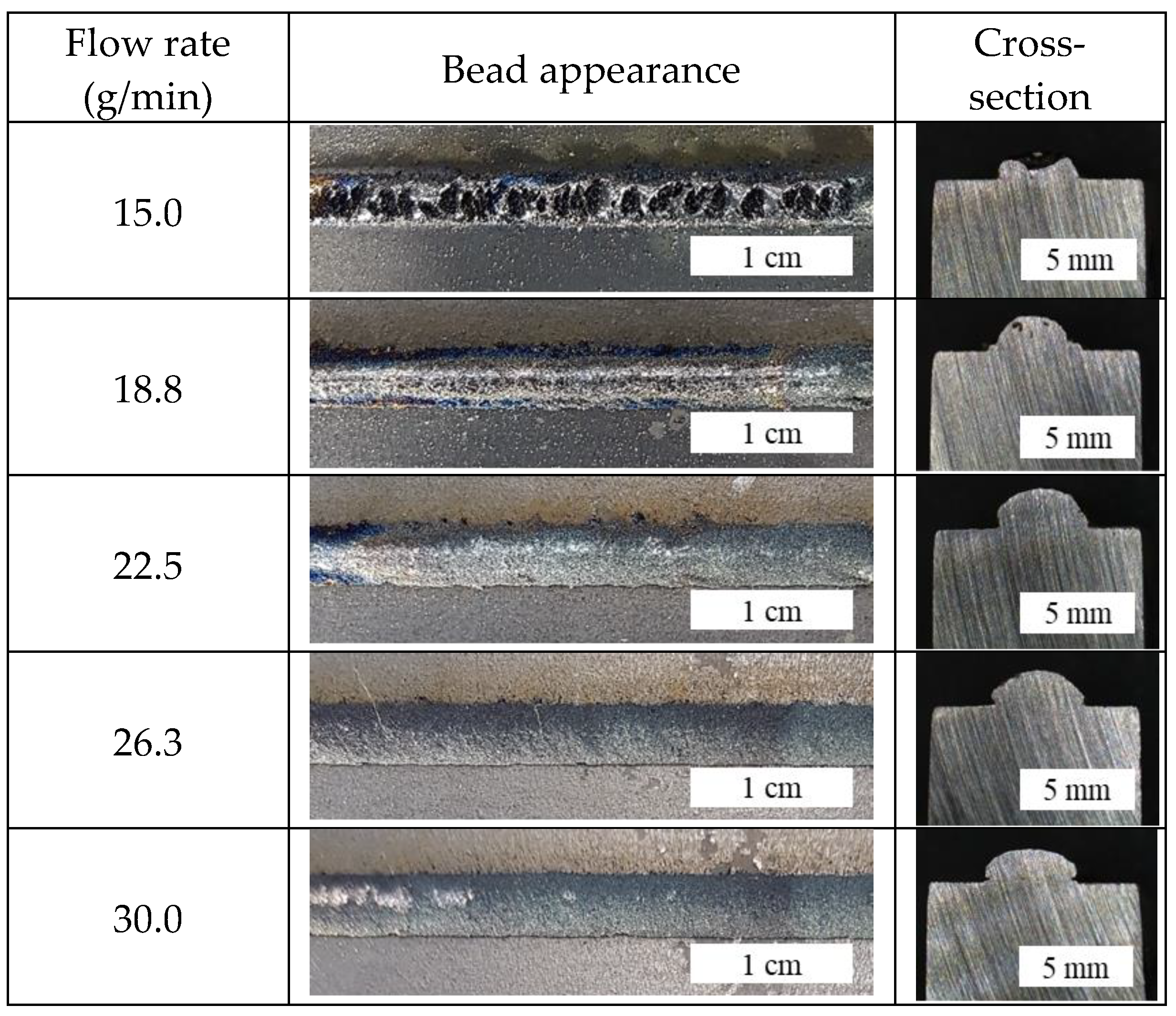
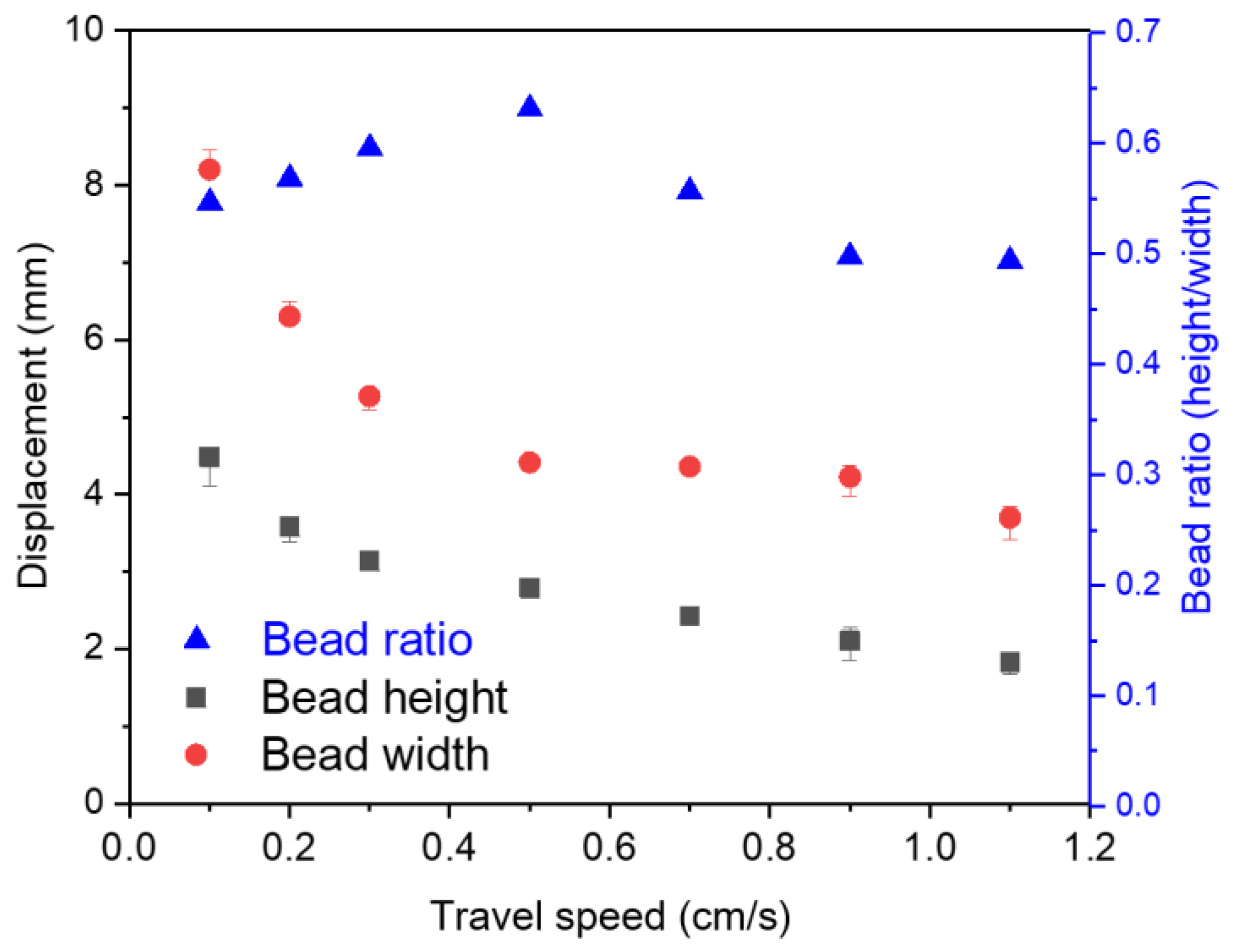
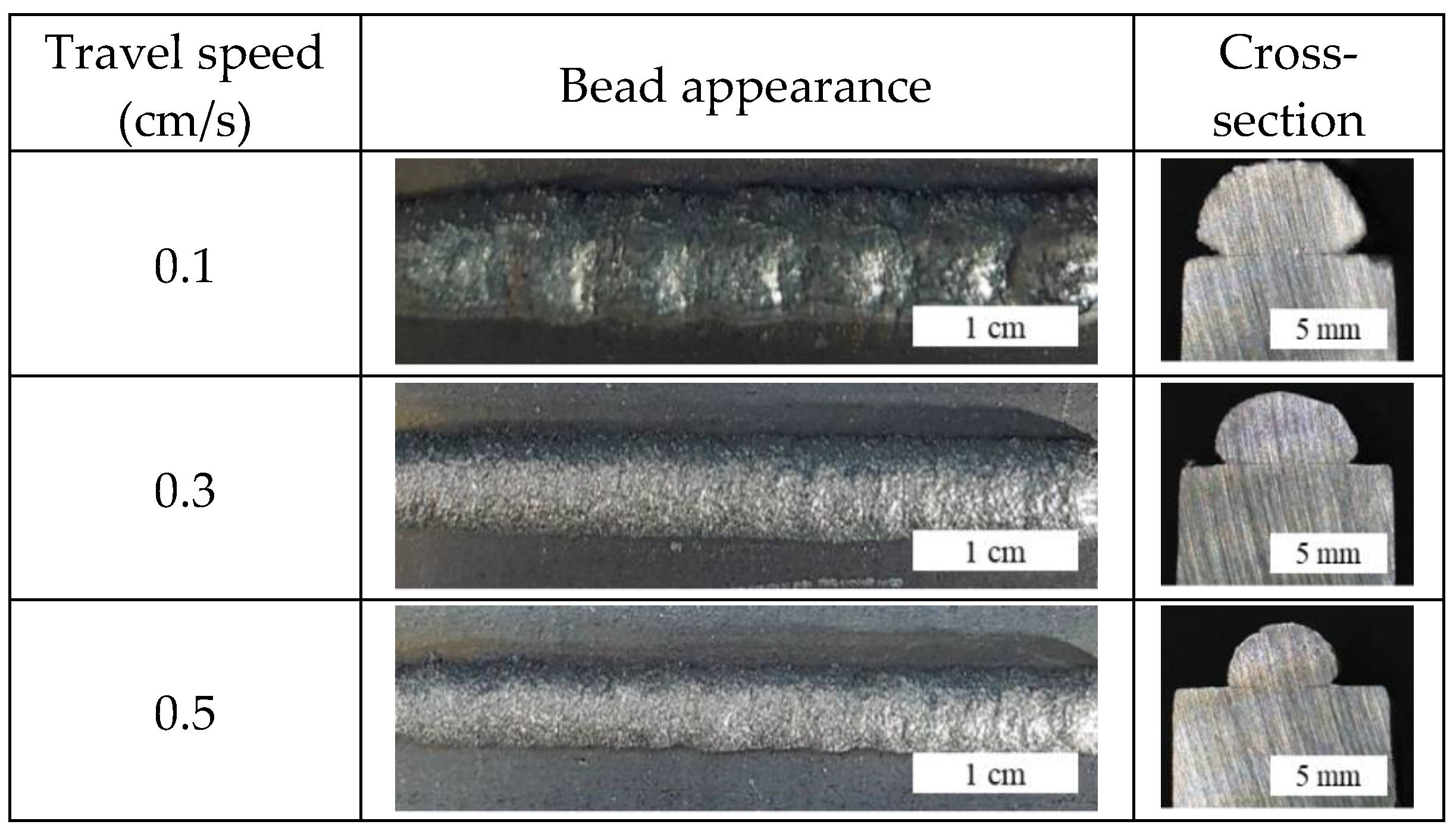


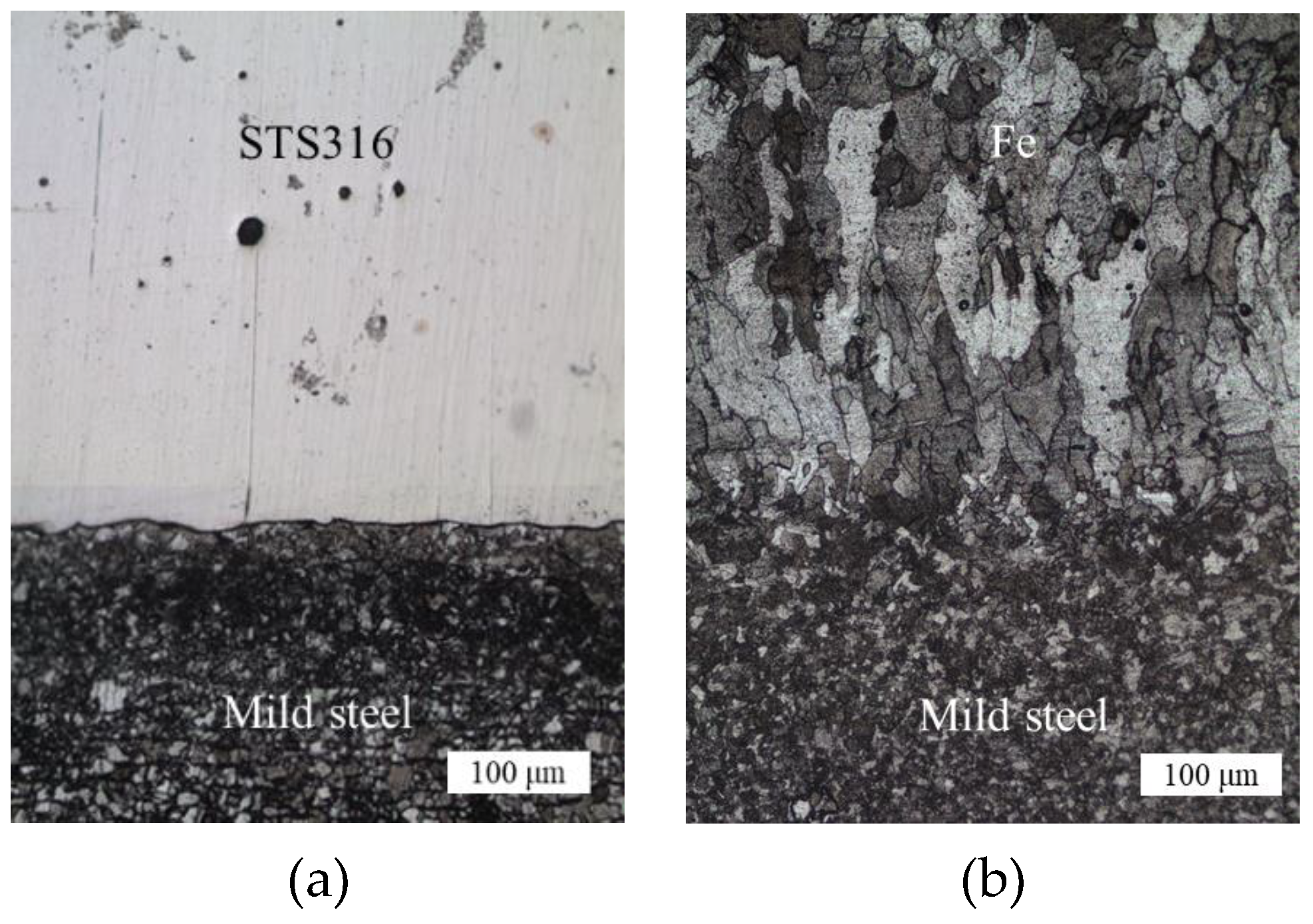
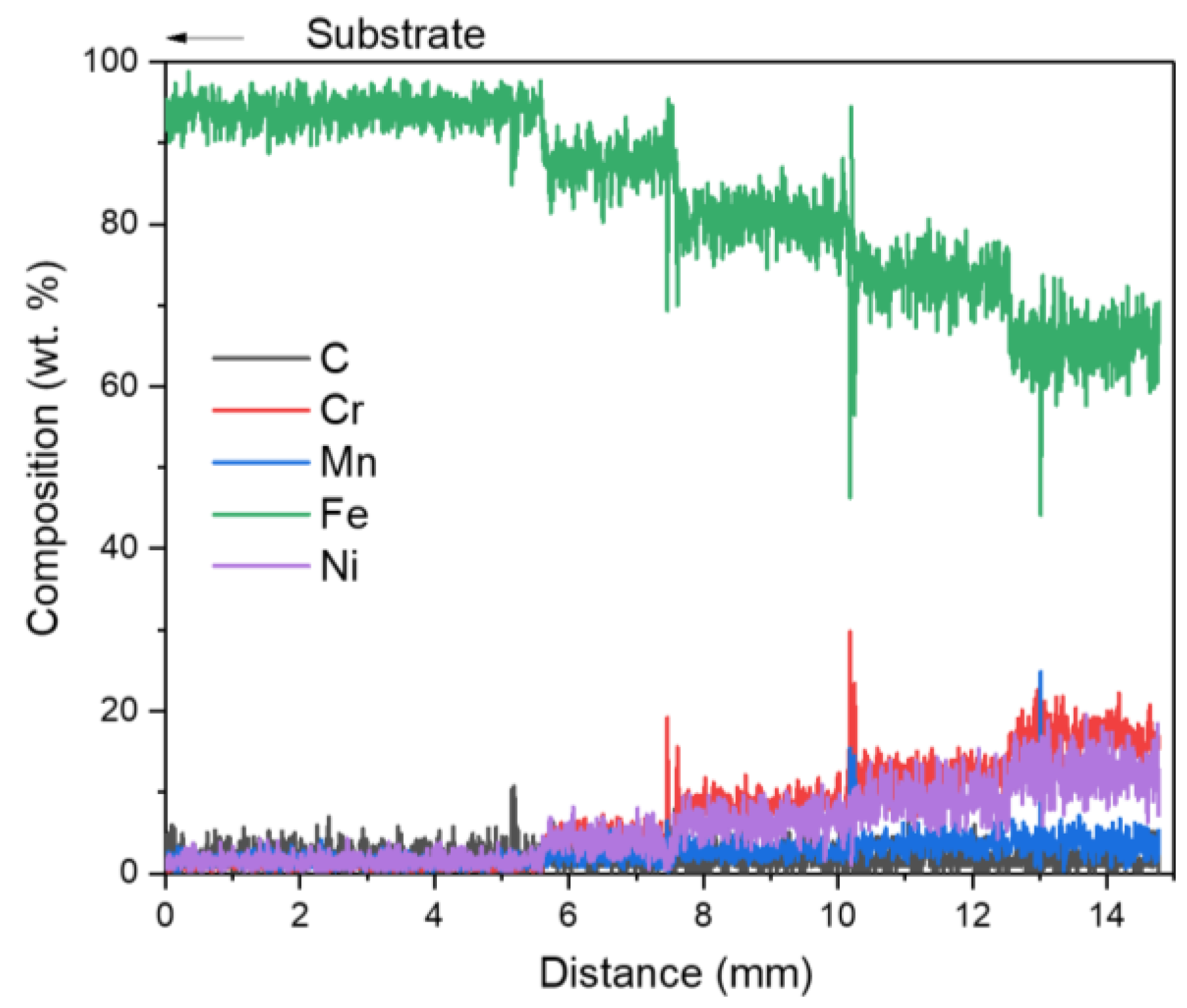


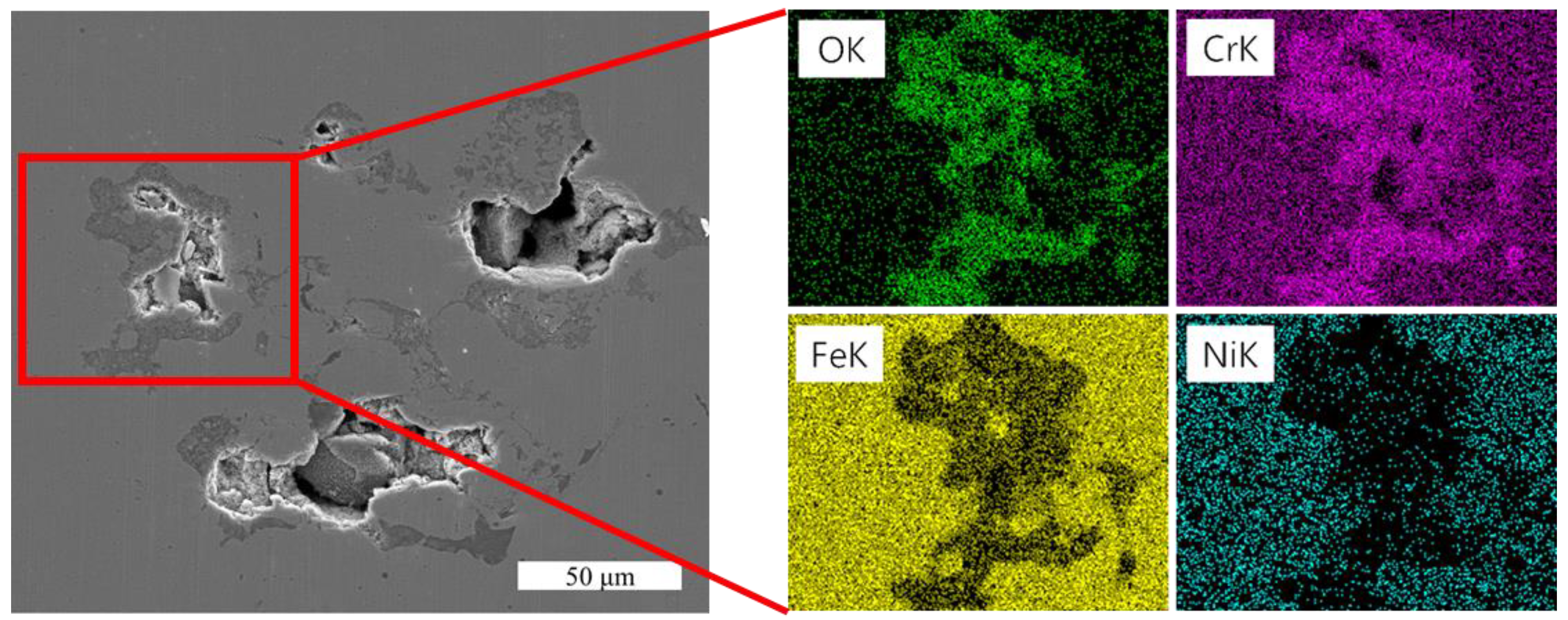
| Powder | Fe | C | O | Si | Mn | P | S | Ni | Cr | Mo |
|---|---|---|---|---|---|---|---|---|---|---|
| STS316 | Bal. | 0.02 | 0.03 | 0.01 | 1.06 | 0.005 | 0.003 | 12.00 | 17.00 | 2.04 |
| Fe | Bal. | 0.01 | 0.15 | 0.08 | 0.13 | 0.008 | 0.006 | 0.005 | 0.005 | 0.003 |
| Process Parameter | Single Pass | Build Production |
|---|---|---|
| Laser Power (kW) | 0.5–2.5 [2] | 2 |
| Travel speed (m/s) | 0.001–0.01 [0.005] | 0.0083 |
| Flow rate (g/min) | 15–30 [20] | 30 |
| Beam Shift (mm) | 0–2 [0] | 0 |
| Contact tip to work-piece distance (mm) | 5–15 [10] | 10–11 |
| Shielding gas (L/min) | 15 (Ar) | 15 (Ar) |
| Carrier gas (L/min) | 10 (Ar) | 10 (Ar) |
| Sample | Sample 1 (Dissimilar Welding) | Sample 2 (Functionally Graded Materials) | |
|---|---|---|---|
| Composition (wt %) | Composition (wt %) | Layer Name | |
| 5th layer | STS316 | 100% STS316 | 0Fe |
| 4th layer | STS316 | 75% STS316 + 25% Fe | 25Fe |
| 3rd layer | STS316 | 50% STS316 + 50% Fe | 50Fe |
| 2nd layer | STS316 | 75% STS316 + 25% Fe | 75Fe |
| 1st layer | STS316 | 100% Fe | 100Fe |
| Substrate | Mild steel | Mild steel | |
| Sieve Number | Particle Size (μm) | Distribution (wt %) * | |
|---|---|---|---|
| Fe | STS316 | ||
| 100 | >150 | 2 | - |
| 140 | 105–150 | 18 | 99 |
| 200 | 74–105 | 29 | |
| 325 | 44–74 | 30 | |
| −325 | <44 | 21 | 1 |
| Process Parameter | CTWD (mm) | Beam Shift (mm) | Laser Power (kW) | Flow Rate (g/min) | Travel Speed (cm/s) |
|---|---|---|---|---|---|
| Value | 10–13 | 0–0.5 | 1.5–2 | 20–30 | 0.5–0.9 |
© 2018 by the authors. Licensee MDPI, Basel, Switzerland. This article is an open access article distributed under the terms and conditions of the Creative Commons Attribution (CC BY) license (http://creativecommons.org/licenses/by/4.0/).
Share and Cite
Nam, S.; Cho, H.; Kim, C.; Kim, Y.-M. Effect of Process Parameters on Deposition Properties of Functionally Graded STS 316/Fe Manufactured by Laser Direct Metal Deposition. Metals 2018, 8, 607. https://doi.org/10.3390/met8080607
Nam S, Cho H, Kim C, Kim Y-M. Effect of Process Parameters on Deposition Properties of Functionally Graded STS 316/Fe Manufactured by Laser Direct Metal Deposition. Metals. 2018; 8(8):607. https://doi.org/10.3390/met8080607
Chicago/Turabian StyleNam, Sangwoo, Heewon Cho, Cheolhee Kim, and Young-Min Kim. 2018. "Effect of Process Parameters on Deposition Properties of Functionally Graded STS 316/Fe Manufactured by Laser Direct Metal Deposition" Metals 8, no. 8: 607. https://doi.org/10.3390/met8080607





